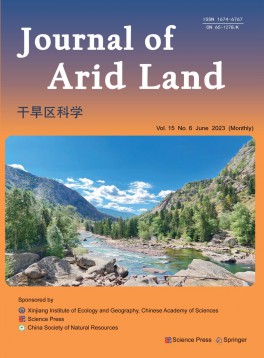Journal of Arid Land雜志是由中國科學院主管,中國科學院新疆生態(tài)與地理研究所;科學出版社主辦的一本CSCD期刊。
Journal of Arid Land雜志創(chuàng)刊于2009,發(fā)行周期為雙月刊,雜志類別為歷史類。

雜志介紹 收藏雜志
Journal of Arid Land雜志是由中國科學院主管,中國科學院新疆生態(tài)與地理研究所;科學出版社主辦的一本CSCD期刊。
Journal of Arid Land雜志創(chuàng)刊于2009,發(fā)行周期為雙月刊,雜志類別為歷史類。
主管單位:中國科學院
主辦單位:中國科學院新疆生態(tài)與地理研究所;科學出版社
國際刊號:1674-6767
國內(nèi)刊號:65-1278/K
發(fā)行周期:雙月刊
Magazine introduction
《Journal of Arid Land》(簡稱JAL)是中國科學院新疆生態(tài)與地理研究所和科學出版社聯(lián)合主辦、科學出版社出版的自然科學綜合性學術(shù)季刊。
《JournalofAridLand》刊登干旱和半干旱地區(qū)水、土、生物、氣候等自然資源變化及其大氣圈、水圈、生物圈、巖石圈之間的相互作用和與人類活動的關(guān)系,干旱和半干旱地區(qū)地理、生態(tài)和環(huán)境格局及生態(tài)建設(shè)和環(huán)境保護,干旱和半干旱區(qū)域?qū)θ蜃兓捻憫c反饋機制等原創(chuàng)性、綜合性、理論性和實用性的研究成果.
《Journal of Arid Land》本刊還開展中亞地區(qū)資源環(huán)境、生態(tài)安全及區(qū)域可持續(xù)發(fā)展的國際學術(shù)交流;同時刊登上述方面的研究評述、快訊、學術(shù)動態(tài)及本領(lǐng)域重要參考書書評等。本刊主要設(shè)有學術(shù)論文、專題評述、研究簡訊、學術(shù)動態(tài)、書評等五個欄目,以國內(nèi)外從事干旱區(qū)自然地理、生物、土壤/土地資源、環(huán)境、氣候、水文水資源、社會科學等方面研究的專家學者,以及這些領(lǐng)域教學和學習的大專院校的教師和學生為讀者對象。
《Journal of Arid Land》于2009年第四季度創(chuàng)刊,目前,在國際上被俄羅斯《文摘雜志》(AJ)VINITI數(shù)據(jù)庫、波蘭《哥白尼索引》(Indexof Copernicus,IC)和美國《烏利希期刊指南》(Ulrich’s Periodicals Directory)收錄,在國內(nèi)被《中國核心期刊(遴選)數(shù)據(jù)庫》、《中國學術(shù)期刊網(wǎng)絡(luò)出版總庫》收錄,并在《中國科技期刊網(wǎng)》、《中國科學院科技期刊開放獲取平臺》、《干旱區(qū)科學》域名網(wǎng)站等網(wǎng)絡(luò)平臺上全文。
欄目設(shè)置: 學術(shù)論文 專題評述 研究簡訊 學術(shù)動態(tài) 書評
Magazine introduction
Keywords: Immediately after the abstract, provide 3 to 7 keywords, closely related to the subject of the article. Avoid general and plural terms and multiple concepts (e.g., 'and', 'of').
Introduction: Provide an adequate background. State the significance, objective and method of the research, citing necessary references, especially references of work published in the last two to three years.
Study area/materials and methods: Introducing a general idea of the study area or experimental setting, the materials and methods used and the basic progress of the study. Provide sufficient detail to allow the work to be reproduced or substantiated.
Methods already published should be indicated by a reference.
Results: Relating the findings and results of the observation(s) and experiment(s) without interpreting their meaning. Results should be clear and concise.
Discussion: Explaining all of your observations within your experiment(s). Exploring the significance of the results, but do not repeat them in the text. Stating whether each of your hypotheses are supported, rejected or if you cannot make a decision with confidence, and suggesting future studies or modifications to the same study.
Conclusions: Presenting main conclusions of the study that may stand alone or creating a discussion subsection.
Acknowledgements: Acknowledgements should include, if applicable, information on grants received, funding organizations, and/or recognition of people who assisted in the research or article.
References: Please cite a reference to acknowledge sources of information from others’ research and results. Ensure that
every reference cited in the text is also present in the reference list. Citation guidelines are as follows: as (Smith, 1998) for single author, as (Smith and Miller, 1999) for two authors, and as (Smith et al., 2006) for three or more authors. Groups of references should be listed first chronologically, then alphabetically. In the reference list, references should be arranged first alphabetically, then chronologically, if necessary. More than one reference from the same author(s) in the same year must be identified by the letters "a", "b", "c", etc., placed after the year of publication. Journal names should not be abbreviated.
Reference examples:
Articles: Ames R N, Reid C P P, Porter L K, et al. 1983. Hyphal uptake and transport of nitrogen from two 15N-labelled
sources by Glomus misseae, a vesicular-arbuscular mycorrhizal fungus. New Phytologist, 95(3): 381?396.
Monograph: Lambers H, Stuart Chapin ΙΙΙ F, Pons T L. 2008. Plant Physiological Ecology. 2nd ed. New York: Springer Science+Business Media, 56?64.
Proceedings: Bernstein N, Kafkafi U. 2002. Root growth under salinity stress. In: Waisel Y, Eshel A, Kafkafi U. Plant Roots,
the Hidden Half. New York: Marcel Dekker Press, 787?805.
Electronic reference: UNESCO World Heritage Centre. 2008. Operational Guidelines for the Implementation of the World
Heritage Convention. Paris: UNESCO World Heritage Centre. [2009-11-17].
Magazine introduction
Magazine introduction
我們不是雜志社。本站主要從事雜志訂閱與期刊推薦服務,不是任何雜志官網(wǎng)。直投稿件請聯(lián)系雜志社,地址:新疆烏魯木齊市北京南路818號,郵編:830011。
本站無論任務服務,事先跟客戶都進行詳細溝通確認,如果沒有按期完成,由本站退還客戶支付的費用。但客戶單方面中止訂單,是不能退款的。
正常情況能滿足大部分的用戶,建議你提前一點時間,如果客戶特別需要加急,需要我們和雜志社溝通安排,如果確認可以會收取一定加急費用。
當然,我們會通過短信或電話主動溝通,匯報進展情況。您也可以撥打您的客服老師電話和我司設(shè)立的投訴電話。
雖然每天面對客戶的需求千差萬別,但我們只能保障盡我們的努力滿足您的要求,為您提供幫助,如果您的某個要求沒得到滿足,我們首先說聲抱歉,也請您不要失望,有問題還請繼續(xù)提問,我們竭誠為您服務
隨著現(xiàn)在各種網(wǎng)站層出不窮的誕生,騙子也越來越多,我們實體公司注冊,實體辦公,網(wǎng)站國家工信部備案,信息公開,可以查詢,從創(chuàng)辦初衷我們就是專注高質(zhì)量的服務,客戶優(yōu)先,注重質(zhì)量。我們的具有保密性,我們對合作過程中的客戶信息安全制定嚴格的管理制度。
Magazine introduction
若用戶需要出版服務,請聯(lián)系出版商,地址:新疆烏魯木齊市北京南路818號,郵編:830011。